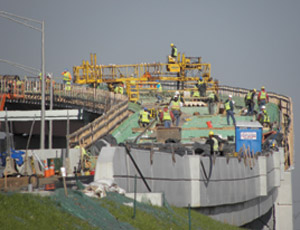While some signs suggest the economic downturn has reached bottom, construction activity in the New York region still languishes with little optimism for a quick rebound.


“It’s very much a mixed picture in terms of what to expect,” says Kenneth D. Simonson chief economist of Associated General Contractors of America in Arlington, Va. “Construction is now at or close to its low point and should start showing improvement in most categories by the end of 2011.”
Data from McGraw-Hill Analytics indicates a slight decline in new starts in 2011 as compared to 2010, with nonbuilding, nonresidential and multifamily housing totaling $36 billion, down from $37.69 billion in 2010. Both McGraw-Hill Analytics and New York Construction are owned by McGraw-Hill. Volume in many project types will be down or flat, with multifamily, utilities, environmental public works, hotels, office and bank buildings, healthcare, and stores and restaurants expected to increase slightly. Nonresidential construction in New York will decline from a five-year high of $17.19 billion in 2010 to $13.52 billion in 2011, while nonresidential will increase slightly in New Jersey and Connecticut.
“Private construction seems to be nearing the bottom,” Simonson says. “Vacancy rates have topped out or are starting to come back down for office and market-rate apartment space. By the second half of 2011, there should be some improvement in spending on those categories.Hospital and university construction, which are quite important in New York City and some parts of upstate and New Jersey, are getting better, after having gone into a deep freeze for two years.”
McGraw-Hill data anticipates a regional increase from $3.69 billion to $4.15 billion in office and bank buildings, a jump from $3.18 billion to $4.2 billion in multifamily housing, and a slight bump in healthcare from $1.18 billion to $1.57 billion.
On the public side, McGraw-Hill projects a decline in highway and bridge spending from $6.23 billion to $5.59 billion but a slight increase in environmental public works, $3.35 billion up from $3.22 billion, and in other public works, $2.56 billion up from $2.43 billion
Many experts were particularly afraid for the future of public infrastructure projects following New Jersey Gov. Chris Christie’s recent decision to scrap the $8.7 billion Trans-Hudson River tunnel project.
“Publicly funded construction is in for a rough time,” Simonson says. “The message from Gov. Christie is pretty clear that he will be very tough on public funding of anything, including construction. The budget mess in New York State makes it unlikely they will be able to add construction money to their spending. That side of construction looks quite weak.”
The New York legislature and new Governor Andrew Cuomo will be wrestling with a $9 billion to $10 billion budget deficit reports Steve Stallmer, vice president of Government & Public Affairs for Associated General Contractors of New York State in Albany.
“That will require cutting spending to fill the gap, because [Cuomo] has committed to not raising taxes,” says Stallmer, adding that the organization hopes highway funding can stay at the current level. Universities, schools and hospitals capital programs will be adversely affected.

KOCSIS

SIMONSON
“On the private side, it’s getting better. Banks are lending more, and we have pockets of private development,” Stallmer says. He offered as an example the $4.2 billion, 1.2 million-sq-ft, four-story chip-fabrication facility for GlobalFoundries in Malta, north of Albany. “I think we have the hit bottom of the valley and we’ve started to head our way back up.”
New York
McGraw-Hill Analytics forecasts $8.53 billion in nonbuilding construction in New York in 2011, up from $7.9 billion in 2010; 13.52 billion in nonresidential building, down from $17.19 billion in 2010; and $5.76 billion in residential construction, up from $4.62 billion in 2010. That totals an expected $27.82 billion in 2011, compared with $29.72 billion in 2010.
On the other hand, the New York Building Congress’ New York City Construction Outlook 2010-2012, reports an expected up tick in construction spending to $25.8 billion in 2011, compared to $23.7 billion in 2010. That includes a slight boost in private spending, from $1.6 billion in 2010 to $1.9 billion in 2011. The forecast also depends on an increase in government spending, from $14.7 billion in 2010 to $15.2 billion in 2011.

SHUBERT
Ronald S. Berger, executive director of the Subcontractors Trade Association in New York, says he thinks the Building Congress’ report sounds reasonable, but he remains unsure about where the government money will come from to support public capital programs.
Building Congress President Richard T. Anderson called the outlook guarded, especially for 2012, when it predicts spending will increase to $28.6 million, including $7.6 billion in spending by the Metropolitan Transportation Authority, money that is not allocated, yet will be need to fund such projects as East Side Access and the Second Avenue Subway. Anderson expects some state money will come through, although perhaps not the full amount requested.
The Building Congress report suggests new sources of revenue, such as congestion pricing or East River bridge tolls. Public-private partnerships could help get transportation projects moving, as they have in other states. The state published a summary of a symposium held on the topic a few years ago but has not formed such partnerships.

Post a comment to this article
Report Abusive Comment